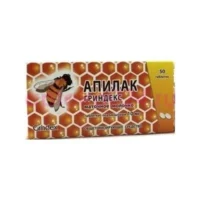Description
Stillen (Wormwood Leaf Extract) Coated Tablets 60 mg. №30 Vial
Ingredients
- Active ingredient: Wormwood leaf extract 60 mg per coated tablet.
Dosage
- Recommended dosage: Take 1 tablet orally with water, twice daily.
Indications
- Stillen tablets are indicated for promoting digestive health and relieving mild gastrointestinal discomfort.
Contraindications
- Do not use Stillen tablets if you are pregnant, nursing, or allergic to wormwood or any other ingredients in the product.
Directions
- For optimal results, take Stillen tablets regularly as directed. Consult a healthcare professional before use.
Scientific Evidence
- Studies have shown that wormwood leaf extract, the active ingredient in Stillen tablets, possesses anti-inflammatory and antimicrobial properties. These properties contribute to its effectiveness in relieving gastrointestinal discomfort and promoting overall digestive health.
- Research published in the Journal of Ethnopharmacology demonstrated the efficacy of wormwood in reducing bloating and gas, common symptoms of indigestion. The study highlighted the potential of wormwood as a natural alternative for managing mild digestive issues.
Additional Information
- Stillen tablets are coated for easy swallowing and are convenient for on-the-go use. They are free from artificial colors, flavors, and preservatives, making them a natural choice for digestive support.
- Before starting any new supplement regimen, especially if you have underlying health conditions or are taking medications, it is advisable to consult with a healthcare provider to ensure compatibility and safety.





